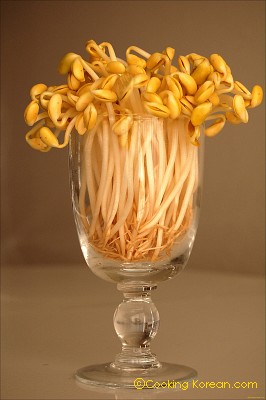
The most time consuming part of this recipe is cleaning the soybean sprout , but you can do it while watching “American Idol” or “Desperate housewives”.
Other than that,it is so easy and quick to make.
Actually,you don’t even have to trim the bean sprouts. The hairy end of it is perfectly edible, but will leave a stringy texture in your mouth and your soup is going to look like Courtney Love’s hair.
This is a very common Korean soup and is especially popular among heavy drinkers. Are you suffering from a hangover this morning? Make this soup and take a slurp from it. It will put your stomach right back in to the mood for another shot of Soju….
*Ingredients (4 portions)
Soybean Sprout : 1/2 lb
Korean radish(or Daikon): size of one apricot
Yellow onion: 1/2
Brown Seaweed: 4 x 4 inches
Green onion: 3
Garlic: 2 cloves
Water: 6 cups
Salt
Pickled shrimp juice
1.Trim off hairy end of bean sprouts, rinse them in water, and drain
2.Peel skin off the yellow onion and leave it whole.
Using a kitchen towel, brush off the white powder on the surface of the brown seaweed.
Rinse green onions in water and leave them whole also.
3.Put bean sprouts, yellow onion, brown seaweed, garlic, and green onions in a pot and pour in water. Boil it with the lid on (Make sure lid is on…otherwise the soup will taste and smell like raw beans)
4.Once the soup starts boiling and a nutty aroma is coming out of the steaming pot, lower the heat to medium and simmer for about 20 minutes.
5.Turn off heat and take out everything except for bean sprouts from the pot.
6.Season with salt and pickled shrimp juice.

